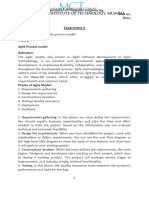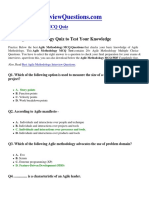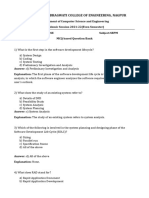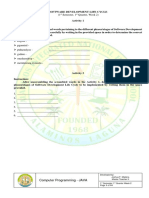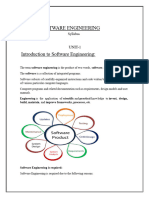Intro - To Software Engineering Worksheet - Chapter 2
Uploaded by
Nabek DeresaIntro - To Software Engineering Worksheet - Chapter 2
Uploaded by
Nabek DeresaDepartment of Software Engineering 2023/2024
Introduction to Software Engineering (SWEN104) Worksheet for Practice and better
Understanding
General Instruction: First, read all the questions carefully and try their answers based on your
classroom learning, then read class notes and related books from library or online resources
and provide proper answer for each question according to its type.
Part I: Choose the correct answer for the following questions.
1. Which of the following shows the correct order of SDLC phases/stages?
A. Planning ➔ Analysis ➔ Design ➔ Testing ➔ Deployment ➔ Implementation
B. Planning ➔ Analysis ➔ Design ➔ Implementation ➔ Deployment ➔Testing
C. Planning ➔ Design ➔ Analysis ➔ Implementation ➔ Testing ➔ Deployment
D. Planning ➔ Analysis ➔ Design ➔ Implementation ➔ Testing ➔ Deployment
2. Which phase of the systems development life cycle (SDLC) determines if the project can
be done?
A. Testing C. Planning
B. Development D. Analysis
3. In the context of SDLC, what is the primary purpose of a Feasibility Study?
A. To define the software's technical architecture.
B. To assess the viability of a project considering technical, economic, and operational
factors.
C. To gather and document detailed system requirements.
D. To create a visual prototype of the user interface
4. How does testing occur in an Agile model?
A. Testing is a separate phase conducted after all development is complete.
B. Testing is integrated throughout the development process in each sprint.
C. There is no testing phase in Agile methodologies.
D. User Acceptance Testing (UAT) is the primary testing method in Agile
5. In the SDLC, what is the primary purpose of the Design phase?
A. To write the code for the software
B. To define the architecture and user interface
C. To test the functionality of the software
D. To release the software to the users
Yimer A. Introduction to Software Engineering (worksheet for chapter-Two) Page 1 of 6
Department of Software Engineering 2023/2024
6. Which methodology advocates for the use of "user stories" to define software
requirements?
A. Scrum C. Crystal
B. Lean D. Feature-Driven Development (FDD)
7. Agile methodologies like Scrum rely on which activity for ongoing communication and
task management within the development team?
A. Formal progress reports
B. Daily Stand-up Meetings
C. Requirement Traceability Matrix (RTM) updates
D. User Acceptance Testing (UAT) session
8. In which methodology does the development team break down the project into small,
manageable tasks and complete them in short iterations called sprints?
A. FDD C. Scrum
B. Extreme Programming (XP) D. Lean
9. In the Waterfall model, which activity results in the creation of a Design Document
Specification (DDS)?
A. Design C. Development
B. Testing D. Deployment
10. In Agile, what is the typical deliverable outcome at the end of a sprint?
A. Signed-off System Requirements Document (SRD)
B. Potentially Shippable Product Increment (working software)
C. Detailed Design Documentation (DDS)
D. User Acceptance Test (UAT) Plan
E. There is no deliverable until the completion of the whole project
11. Which methodology involves continuous monitoring of work items on a visual board, with
the goal of identifying bottlenecks and improving flow?
A. Scrum C. Kanban
B. Extreme Programming (XP) D. Spiral
12. Which methodology emphasizes delivering value to the customer early and often through
frequent releases?
A. Lean C. Kanban
B. Scrum D. V-model
Yimer A. Introduction to Software Engineering (worksheet for chapter-Two) Page 2 of 6
Department of Software Engineering 2023/2024
13. Which Agile framework emphasizes more on self-organizing cross-functional teams?
A. Kanban C. Scrum
B. Lean D. Extreme Programming (XP
14. In Agile, what is the primary role of the Product Owner?
A. Managing the development team.
B. Prioritizing the backlog and representing the customer.
C. Facilitating the daily stand-up meetings.
D. Ensuring the completion of tasks within a sprint
15. What is the purpose of the Sprint Retrospective meeting in Scrum?
A. To review and update the product backlog.
B. To plan the tasks for the next sprint.
C. To reflect on the team's processes and identify areas for improvement.
D. To demonstrate the increment to stakeholders
16. What are the three roles in the Scrum framework?
A. Scrum Master, Product Owner, Development Manager
B. Scrum Master, Product Owner, Development Team
C. Project Manager, Product Owner, Development Team
D. Scrum Master, Project Manager, Development Team
17. What does the Kanban board visualize?
A. Product backlog items
B. Sprint backlog items
C. Work in progress (WIP) and workflow
D. Completed tasks
18. What is the main focus of Lean thinking?
A. Maximizing efficiency by any means necessary
B. Delivering products quickly regardless of quality
C. Eliminating waste and optimizing value delivery
D. Expanding production capacity to meet demand
E. All of the above
19. Who is responsible for prioritizing items in the product backlog?
A. Scrum Master C. Development Team
B. Product Owner D. Stakeholder.
Yimer A. Introduction to Software Engineering (worksheet for chapter-Two) Page 3 of 6
Department of Software Engineering 2023/2024
20. What is the purpose of the Daily Stand-up (Scrum) or Daily Kanban (Kanban) meeting?
A. To report progress to management
B. To discuss technical issues
C. To synchronize the team's activities and identify obstacles
D. To plan the next sprint
21. What is the main advantage of the Agile SDLC model?
A. Strict adherence to a pre-defined plan
B. Flexibility to adapt to changing requirements
C. Comprehensive documentation before development
D. Suitable for large-scale, complex projects only
E. All of the above
22. What is the primary goal of a sprint planning in scrum?
A. Reviewing and improving team processes
B. Planning the next sprint
C. Demonstrating the product to stakeholders
D. Estimating the effort required for upcoming task
E. A & C
F. B & D
Part II: Write true if the statement is correct and false if it is wrong for the following
questions.
23. Scope creep and communication gaps are common challenges in SDLC.
24. In both Waterfall and Agile, design phase focuses on identifying and correcting errors in
the software.
25. Scrum is a framework that is a lightweight and simple to understand but difficult to master.
26. The Scrum Master is responsible for assigning tasks to team members during a sprint.
27. A project team can estimate accurate timeline by breaking down tasks into smaller and
more manageable units.
28. Kanban is a time-boxed iterative framework.
29. Extreme Programming (XP) focuses solely on technical practices and ignores customer
feedback.
Yimer A. Introduction to Software Engineering (worksheet for chapter-Two) Page 4 of 6
Department of Software Engineering 2023/2024
30. Extreme Programming (XP) advocates for pair programming as a way to improve code
quality.
31. Scrum team can be established with two persons.
32. Lean focuses solely on maximizing efficiency without considering customer value.
33. In agile development, definition of ready represents criteria for acceptance of user stories,
while definition of done represents minimum requirements for adding items to the backlog.
Part III: Fill in the blanks with the missing words or phrases for the following questions.
34. SDLC stands for _______________________
35. __________ is responsible for managing the product backlog.
36. Fix bugs and resolve system issues performed at _____________ phase of SDLC.
37. ____________ is the launching of the software to production environment
38. The Scrum Master acts as a ________ for the development team, facilitating and removing
obstacles
39. The primary goal of the Sprint Review is to gather _____ from stakeholders.
40. The Scrum Master serves as a _____ for the team, ensuring adherence to Agile principles.
41. Reviewing and coordinating work between multiple Scrum teams is called _________
42. During a Sprint, the Development Team works to complete the ____________
43. The primary artifact in Scrum that represents the list of desired work is called the _____
44. Kanban encourages limiting _____ to improve flow and focus on completing tasks.
45. The Kanban board typically consists of columns representing different stages in the ______
46. _____________ and ____________ are the two major organizations that publish standards
and specifications relevant to software development.
Part IV: Provide Short answer for the following questions
47. Explain the concept of sprints in scrum.
48. List the four main events in Scrum framework.
49. What is the purpose of a burndown chart in Agile development?
50. What is the importance of the product backlog in Agile development?
51. How does Kanban and lean facilitate continuous improvement?
52. How Kanban differ from scrum and lean?
53. What is Scrum life cycle and why the recommended duration of a sprint is 1 – 4 weeks?
Yimer A. Introduction to Software Engineering (worksheet for chapter-Two) Page 5 of 6
Department of Software Engineering 2023/2024
Part V: Provide detail explanations for the following questions.
54. Explain why it's important to follow a structured process like SDLC in software
development.
55. Compare and contrast the activities and deliverables of planning and requirement analysis
phase in waterfall and agile.
56. List the activities and deliverables of design, building and testing phases of SDLC and
explain the differences when it applied to waterfall and agile methodologies.
57. Briefly explain what Scrum is and list its main components.
58. Describe the role of the Development Team in Agile (scrum) projects
59. Discuss scrum of scrum, SAFe and LeSS concepts in agile methodology.
60. In Agile, stakeholders are considered to be part of the team, describe their role in each
phase of the SDLC and explain why their involvement is critical for project success.
61. Compare and contrast the roles of Product Owner and Scrum Master in the Scrum
framework.
62. Describe the principles of Lean and XP.
Part VI: Analyze the following case scenario and provide your answer by relating with the
topics leaned from the chapter.
63. Imagine a case where a software project is behind schedule during the implementation
phase. How might this impact subsequent phases of the SDLC, and what actions could be
taken to mitigate the delay?
64. Assume, you are part of a software development team using Agile methodologies. During
a sprint review, the client requests a significant change to the project scope. How should
the team respond according to Agile principles?
65. Consider a scenario where a development team encounters challenges in estimating the
effort required for user stories during sprint planning sessions. How might they improve
their estimation accuracy and reliability to enhance project predictability and delivery?
“With the right people, you can build anything! - Joel Spolsky”
Yimer A. Introduction to Software Engineering (worksheet for chapter-Two) Page 6 of 6
You might also like
- Hourglass Workout Program by Luisagiuliet 276% (21)Hourglass Workout Program by Luisagiuliet 251 pages
- The Hold Me Tight Workbook - Dr. Sue Johnson100% (16)The Hold Me Tight Workbook - Dr. Sue Johnson187 pages
- Read People Like A Book by Patrick King-Edited62% (65)Read People Like A Book by Patrick King-Edited12 pages
- Livingood, Blake - Livingood Daily Your 21-Day Guide To Experience Real Health77% (13)Livingood, Blake - Livingood Daily Your 21-Day Guide To Experience Real Health260 pages
- COSMIC CONSCIOUSNESS OF HUMANITY - PROBLEMS OF NEW COSMOGONY (V.P.Kaznacheev,. Л. V. Trofimov.)94% (212)COSMIC CONSCIOUSNESS OF HUMANITY - PROBLEMS OF NEW COSMOGONY (V.P.Kaznacheev,. Л. V. Trofimov.)212 pages
- Donald Trump & Jeffrey Epstein Rape Lawsuit and Affidavits83% (1016)Donald Trump & Jeffrey Epstein Rape Lawsuit and Affidavits13 pages
- The 36 Questions That Lead To Love - The New York Times94% (34)The 36 Questions That Lead To Love - The New York Times3 pages
- The 36 Questions That Lead To Love - The New York Times95% (21)The 36 Questions That Lead To Love - The New York Times3 pages
- Jeffrey Epstein39s Little Black Book Unredacted PDF75% (12)Jeffrey Epstein39s Little Black Book Unredacted PDF95 pages
- The 4 Hour Workweek, Expanded and Updated by Timothy Ferriss - Excerpt23% (954)The 4 Hour Workweek, Expanded and Updated by Timothy Ferriss - Excerpt38 pages
- DASA DevOps Fundamentals - Mock Exam - English100% (1)DASA DevOps Fundamentals - Mock Exam - English27 pages
- Test Questions: PMI-ACP Lite Mock Exam 6 Practice QuestionsNo ratings yetTest Questions: PMI-ACP Lite Mock Exam 6 Practice Questions14 pages
- Multiple Choice Quiz With Answers PressmanNo ratings yetMultiple Choice Quiz With Answers Pressman18 pages
- Intro - To Software Engineering Worksheet - Chapter 1No ratings yetIntro - To Software Engineering Worksheet - Chapter 15 pages
- The University of Lahore: Department of Computer Science& IT Midterm Examination Fall-2020 (SOLUTION)No ratings yetThe University of Lahore: Department of Computer Science& IT Midterm Examination Fall-2020 (SOLUTION)5 pages
- Test Questions: PMI-ACP Lite Mock Exam 8 Practice QuestionsNo ratings yetTest Questions: PMI-ACP Lite Mock Exam 8 Practice Questions14 pages
- Patrina Perreira-System-Analysis-and-Design-2019-exam-1No ratings yetPatrina Perreira-System-Analysis-and-Design-2019-exam-19 pages
- University of Ghana: Second Semester University ExaminationNo ratings yetUniversity of Ghana: Second Semester University Examination8 pages
- Software Life Cycle, Software Engineering Paradigms With MCQNo ratings yetSoftware Life Cycle, Software Engineering Paradigms With MCQ52 pages
- End Term Exam 2022 - MCAGC3009 Agile Software DevelopmentNo ratings yetEnd Term Exam 2022 - MCAGC3009 Agile Software Development9 pages
- 2018 DASA DevOps Fundamentals - Mock Exam - EnglishNo ratings yet2018 DASA DevOps Fundamentals - Mock Exam - English22 pages
- PSPO-I Professional Scrum Product Owner I Free Updated DumpsNo ratings yetPSPO-I Professional Scrum Product Owner I Free Updated Dumps10 pages
- Pass GAQM CSM-001 Exam With 100% Guarantee: Certified Scrum Master (CSM)No ratings yetPass GAQM CSM-001 Exam With 100% Guarantee: Certified Scrum Master (CSM)11 pages
- Scrum Master Certification - Sample ExamNo ratings yetScrum Master Certification - Sample Exam8 pages
- Software Engineering MCQ (Multiple Choice Questions)No ratings yetSoftware Engineering MCQ (Multiple Choice Questions)26 pages
- MU - SCIENCE - BSCIT - TY BSCIT Sem 5 - USIT501 - 2020-12-01 - MCQ - 2 - UnitNo ratings yetMU - SCIENCE - BSCIT - TY BSCIT Sem 5 - USIT501 - 2020-12-01 - MCQ - 2 - Unit3 pages
- Chapter 4 - Cabling, Connectors and Network DevicesNo ratings yetChapter 4 - Cabling, Connectors and Network Devices24 pages
- Data Communications Chapter 7 Network SecurityNo ratings yetData Communications Chapter 7 Network Security26 pages
- Data Communications - PPTX Chapter 1 V1No ratings yetData Communications - PPTX Chapter 1 V131 pages
- Software Engineering - Project Management Concepts MCQs ExamRadar - 10% (1)Software Engineering - Project Management Concepts MCQs ExamRadar - 18 pages
- 1st Sem 1st QTR - Week 2 Module in Computer Programming JAVA - Modular 14 Pages100% (1)1st Sem 1st QTR - Week 2 Module in Computer Programming JAVA - Modular 14 Pages14 pages
- Software Engineering For Game DevelopmentNo ratings yetSoftware Engineering For Game Development56 pages
- Project Report On ONLINE - EXAMINATION PDFNo ratings yetProject Report On ONLINE - EXAMINATION PDF117 pages
- Livingood, Blake - Livingood Daily Your 21-Day Guide To Experience Real HealthLivingood, Blake - Livingood Daily Your 21-Day Guide To Experience Real Health
- COSMIC CONSCIOUSNESS OF HUMANITY - PROBLEMS OF NEW COSMOGONY (V.P.Kaznacheev,. Л. V. Trofimov.)COSMIC CONSCIOUSNESS OF HUMANITY - PROBLEMS OF NEW COSMOGONY (V.P.Kaznacheev,. Л. V. Trofimov.)
- Donald Trump & Jeffrey Epstein Rape Lawsuit and AffidavitsDonald Trump & Jeffrey Epstein Rape Lawsuit and Affidavits
- The 36 Questions That Lead To Love - The New York TimesThe 36 Questions That Lead To Love - The New York Times
- The 36 Questions That Lead To Love - The New York TimesThe 36 Questions That Lead To Love - The New York Times
- Jeffrey Epstein39s Little Black Book Unredacted PDFJeffrey Epstein39s Little Black Book Unredacted PDF
- The 4 Hour Workweek, Expanded and Updated by Timothy Ferriss - ExcerptThe 4 Hour Workweek, Expanded and Updated by Timothy Ferriss - Excerpt
- Test Questions: PMI-ACP Lite Mock Exam 6 Practice QuestionsTest Questions: PMI-ACP Lite Mock Exam 6 Practice Questions
- Intro - To Software Engineering Worksheet - Chapter 1Intro - To Software Engineering Worksheet - Chapter 1
- The University of Lahore: Department of Computer Science& IT Midterm Examination Fall-2020 (SOLUTION)The University of Lahore: Department of Computer Science& IT Midterm Examination Fall-2020 (SOLUTION)
- Test Questions: PMI-ACP Lite Mock Exam 8 Practice QuestionsTest Questions: PMI-ACP Lite Mock Exam 8 Practice Questions
- Patrina Perreira-System-Analysis-and-Design-2019-exam-1Patrina Perreira-System-Analysis-and-Design-2019-exam-1
- University of Ghana: Second Semester University ExaminationUniversity of Ghana: Second Semester University Examination
- Software Life Cycle, Software Engineering Paradigms With MCQSoftware Life Cycle, Software Engineering Paradigms With MCQ
- End Term Exam 2022 - MCAGC3009 Agile Software DevelopmentEnd Term Exam 2022 - MCAGC3009 Agile Software Development
- 2018 DASA DevOps Fundamentals - Mock Exam - English2018 DASA DevOps Fundamentals - Mock Exam - English
- PSPO-I Professional Scrum Product Owner I Free Updated DumpsPSPO-I Professional Scrum Product Owner I Free Updated Dumps
- Pass GAQM CSM-001 Exam With 100% Guarantee: Certified Scrum Master (CSM)Pass GAQM CSM-001 Exam With 100% Guarantee: Certified Scrum Master (CSM)
- Software Engineering MCQ (Multiple Choice Questions)Software Engineering MCQ (Multiple Choice Questions)
- MU - SCIENCE - BSCIT - TY BSCIT Sem 5 - USIT501 - 2020-12-01 - MCQ - 2 - UnitMU - SCIENCE - BSCIT - TY BSCIT Sem 5 - USIT501 - 2020-12-01 - MCQ - 2 - Unit
- Chapter 4 - Cabling, Connectors and Network DevicesChapter 4 - Cabling, Connectors and Network Devices
- Software Engineering - Project Management Concepts MCQs ExamRadar - 1Software Engineering - Project Management Concepts MCQs ExamRadar - 1
- 1st Sem 1st QTR - Week 2 Module in Computer Programming JAVA - Modular 14 Pages1st Sem 1st QTR - Week 2 Module in Computer Programming JAVA - Modular 14 Pages








































































